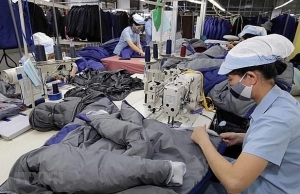Gap must be narrowed in nation’s labour productivity
At last week’s Vietnam Socioeconomic Forum 2023 in Hanoi, Felix Weidencaff, youth employment specialist at the International Labour Organization (ILO) Regional Office for Asia-Pacific, said that the long-term downward trend in productivity growth was taking place globally, posing many challenges.
 |
| In a round-table discussion (VNA) |
“This is caused by the fluctuations in the macroeconomy around the world like inflation, geopolitical tensions, food/energy prices, commitments to reduce greenhouse gas emissions and required resources, and limitations of resources,” Weidencaff said, pointing out that productivity in Vietnam was still lower than some ASEAN countries.
According to the General Statistics Office, the productivity of Vietnam in 2021 rose to $7,300 per employee, and $7,900 in 2022. The average in 2011-2022 increased by 5.3 per cent annually, higher than the growth of Malaysia at 1.4 per cent, Thailand 1.9 per cent, and Singapore 2.2 per cent.
Vietnam has been narrowing down the gap with these neighbouring countries. Compared to developed economies, Vietnam’s productivity is equal to 15.4 per cent of the US, 19.1 per cent of France, 21.6 per cent of the UK, 26.3 per cent of Japan, and 59 per cent of China.
Explaining the reason for low productivity, Nguyen Le Hoa, head of the Productivity Research Division at the Vietnam Productivity Institute raised some objective and subjective causes.
“In Vietnam, there is a shortage of highly skilled workers. The private sector accounts for a large proportion, but most of them are small and microscale, so it is difficult to improve labour productivity,” Hoa said.
Recently, many policies have been introduced to boost labour productivity, such as innovating growth models, solving administrative procedures, and innovating sci-tech. Nevertheless, the process of implementation is too slow, and supportive programmes for businesses do not attract participation.
“Although all policies focusing on restructuring the economy have made a positive impact on productivity growth in Vietnam, intra-industry productivity has not been as expected. Industries contribute much to GDP and use a lot of labour, but productivity is still low, and growth is not as much as expected,” Hoa added.
In 2021, productivity growth was at 4.6 per cent on-year. In 2022, despite the high GDP growth rate of 8.02 per cent, productivity growth was at 4.7 per cent only. These growth rates are far from the goals set forth for 2025 and 2030, at 6.5 per cent per year.
Sharing the international experience in enhancing productivity for socioeconomic development and recovery, Jonathan Pincus, senior international economist at the United Nations Development Programme im Vietnam, said there were only about a dozen countries that can maintain long-term productivity growth, of which the US is ahead of the pack.
“The common thing of these countries is that they are successful exporters. They seize the overseas demand to increase the scale of production in both industrial and agricultural sectors,” Pincus said.
Previously, in the ASEAN region, Thailand and Malaysia had a rapid productivity growth rate, however, they could not maintain this rate after the financial crisis in Asia.
“They failed to upgrade their development policies when they reached the middle-income level, but continued to pursue growth based on low-cost exports without innovating and upgrading technologies and the capacity of domestic manufacturing industries,” Pincus added.
Vietnam is a middle-income country with admirable growth, but the country is struggling to avoid the middle-income trap like the aforementioned countries. The key is that Vietnam must succeed in building a national innovation system, Pincus said. He also highlighted the intensive, post-graduate training in Vietnam, adding that there were not enough spaces in higher education, especially in science and engineering.
“While businesses are interested in investing, the country should prepare carefully to upgrade its capacity. Many international students in developed countries and sci-tech talents should be encouraged to work in institutes and schools in the country,” Pincus said.
 | Vietnam’s labour productivity needs to catch up with ASEAN Vietnam’s labour productivity has improved but is still low in comparison with other ASEAN members, according to a report by the Ministry of Planning and Investment. |
 | Boosting labour productivity to cope with pandemic aftermath There is a critical need in Vietnam to enhance skills for workers. Nguyen Chi Truong, director of the Occupational Skills Department at the Ministry of Labour, Invalids, and Social Affairs, spoke to VIR’s Thai An on preparing properly for the recovery of the labour market after the pandemic threat drops. |
What the stars mean:
★ Poor ★ ★ Promising ★★★ Good ★★★★ Very good ★★★★★ Exceptional
Related Contents
Latest News
More News
- Protect what’s next: towards a future free from meningococcal group B disease (December 05, 2025 | 18:00)
- New ILO report offers policy recommendations for disability inclusion (December 04, 2025 | 15:18)
- Maternal job loss may affect children’s mental health, research shows (December 03, 2025 | 19:11)
- Women lead Vietnam’s shift to climate-resilient agriculture (December 03, 2025 | 19:10)
- Experts highlight unpaid care work as key barrier to gender equality (December 03, 2025 | 15:15)
- Opportunities and inequalities for women workers in Vietnam's garment industry (December 03, 2025 | 09:00)
- Vietjet flights carry love to devastated central region (November 28, 2025 | 11:35)
- New initiative to boost the fight against domestic violence (November 26, 2025 | 10:00)
- South Korea funds IOM relief for Vietnam’s typhoon-affected communities (November 24, 2025 | 15:33)
- AI and human-centred values set to shape the future of HR in Vietnam (November 21, 2025 | 18:04)

 Tag:
Tag:




















 Mobile Version
Mobile Version